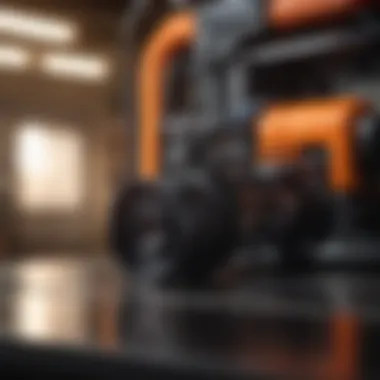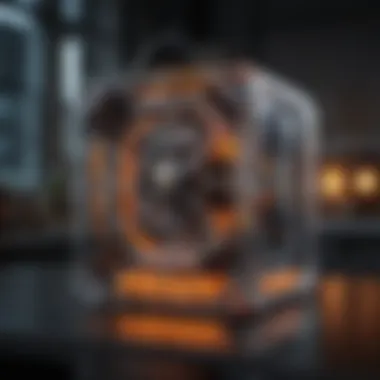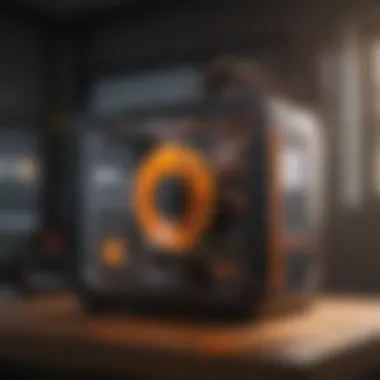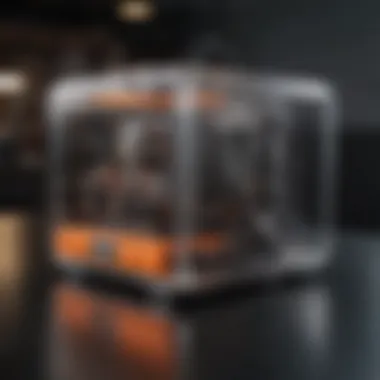Is Prusa the Ultimate Choice in 3D Printing?


Overview
Prelims
The rise of 3D printing technology has disrupted various industries, defining new pathways for creativity and production. Among the players in this vibrant sector, Prusa 3D printers have carved a distinctive niche. Known for their open-source designs and constructive community, these printers have sparked dialogue among both enthusiasts and casual users alike regarding their performance and reliability in the realm of additive manufacturing.
Brief Background
Josef Prusa, the mind behind Prusa Research, positioned his printers as user-friendly yet solid options in the competitive landscape. While there are many brands available today, Prusa often emerges as a leading choice due to its consistent performance and the vibrant user base supporting it. Understanding whether Prusa stands out requires diving deep into the workings, capabilities, and user experiences associated with the printers.
Features & Specifications
The true strength of a 3D printer lies in its specifications and standout features. Prusa printers offer several characteristics worthy of attention:
- Build Volume: Variants like the Prusa i3 MK3S+ boast substantial build volumes at 250 x 210 x 210 mm, promoting varied project potential.
- Print Head: The printers utilize an advanced auto bed leveling sensor, ensuring prints adhere better and offering a more efficient first layer experience.
- Material Compatibility: Users benefit from a wide array of compatible filaments, including PLA, ABS, PETG, and more, appealing to diverse project needs.
- Speed and Precision: Featuring precise layer resolution, these printers can yield duplicates in a shorter timeframe compared to some competitors.
- Firmware and Software: Prusa’s in-house slicer, PrusaSlicer, allows for optimal control over the printing process while maintaining user intuition via its straightforward interface.
Pros and Cons
Understanding the benefits and drawbacks of Prusa printers provides insights into whether they truly can be labelled the best:
Pros
- Exceptional print quality and detail.
- Strong customer support network and community resources.
- Modular build allows for easier upgrades and modifications.
- Regular firmware updates ensure ongoing improvements.
Cons
- Initial costs may be higher compared to some entry-level counterparts.
- Assembly required can deter some novice users, despite clarity of instructions.
- Limited availability of certain parts in regional areas can cause delays in maintenance.
User Experience
Reviews from real-world users enhance understanding of Prusa printers. A significant number of users laud their ease of setup and consistent results.
“The precision is unmatched. I transitioned from a different brand and I've seen immediate results. Less time troubleshooting and more time designing.” – Alex, 3D Printing Enthusiast.
Feedback points to Prusa’s strong community presence as a major advantage. Many users report rich discussions on forums like reddit.com, where tips and experiences are flow freely. Problems often receive swift resolutions from the community or the brand itself.
Buying Guide
When considering a Prusa printer, buyers may want to assess:
- Project Needs: Analyze your typical printing requirements.
- Budget: Assess if the investment aligns with expected outcomes.
- Community: Look into the available support from forums or local groups that use the same model.
- Future Upgrades: Identify if you're interested in evolving your print technology understanding and often innovative capabilities.
Acknowledging these aspects will guide potential buyers in making informed decisions regarding a potentially substantial investment.
For more insights on related technology and developments, one can explore platforms like en.wikipedia.org or engage in discussions on facebook.com.
Intro
The field of 3D printing has matured significantly over the years. As technology progressed, various brands arose, each trying to capture the attention of both hobbyists and professionals. Among these brands, Prusa has garnered considerable attention. This section explores the specific elements that outline why analyzing Prusa's position in the 3D printing market is crucial.


With various options available, including top competitors like Ultimaker, Creality, and Anycubic, it’s vital to assess what sets Prusa apart. Evaluating its distinct features, market reputation, and user experiences offers insight into whether Prusa stands above the rest.
Many users seek reliability and excellence in their printing devices. Purchasing a 3D printer often comes after intensive research in this rapidly evolving field. By examining aspects such as build quality, precision, and customer support, we aim to provide comprehensive resources that help novice and experienced users determine the best choice for their applications.
As 3D printing continues to grow in sectors like manufacturing, healthcare, and even fashion, identifying the best tools becomes indispensable. This discussion delves deeper into Prusa’s ascent and the qualities that have fostered its acclaim.
Understanding 3D Printing
3D printing, or additive manufacturing, entails creating three-dimensional objects layer by layer. Initially considered a niche technology, it now permeates industries such as aerospace and healthcare. The basics are straightforward: a digital file is transformed into a physical item via a specialized printer, typically using materials like plastic.
There are various techniques utilized in 3D printing, the most common include Fused Deposition Modeling (FDM) and Stereolithography (SLA). Each method possesses disciples and application focuses. Grasping this foundation helps users appreciate the advancements made by companies, including Prusa, within the 3D printing realm.
The Rise of Prusa in the 3D Printing Community
Prusa has emerged as a significant player in the 3D printing landscape, credited with pioneering user-friendly machines. Founded by Josef Prusa, the company has successfully combined open-source principles and innovative design. Introduced in 2012, Prusa's models demonstrated superior ease-of-use, flexibility, and quality.
A lurking community support basks around the Prusa brand. Enthusiasts often share information, designs, and modifications online, creating a robust ecosystem that fosters innovation. This extensive community engagement contributes to the platform's emerging learning resources created by users or consumer-generated content on forums like Reddit.
Prusa printers are often noted for their high customer satisfaction, making them prominent choices for both personal and professional projects.
Much of Prusa's success stems from its transparency and knowledge sharing. By making resources available like the PrusaSlicer software, they embolden ownership designed printers, where transparent modifications and upgrades elevate the user experience. Such factors have solidified Prusa's status as a reliable choice within the 3D printing community.
Key Features of Prusa Printers
Understanding the key features of Prusa printers is critical for assessing their performance in the 3D printing arena. These features encapsulate the quality, functionality, and user-friendliness that users often prioritize during their purchasing decisions. When evaluated thoroughly, they reveal why these printers have attained recognition among both novices and seasoned enthusiasts.
Build Quality and Design
Prusa printers typically display strong build quality. They often feature a solid frame made of aluminum, which contributes to their durability and reduces vibrations during operation. An important aspect is their open-frame design that allows users to easily access the printing area.
The design lays ground for modifications, enabling tinkerers and advanced users to make enhancements suitable for individual preferences.
More than just aesthetics, thoughtful design in Prusa printers often translates to enhanced performance. User reviews frequently mention how the robust structure aids in maintaining print accuracy and reducing any wake or wobbling that could disrupt quality.
Easy Assembly and Setup
One significant advantage of Prusa printers is their straightforward assembly process. Most users find that following the provided instructions results in a successful setup without unnecessary complications. This ease of assembly stands out particularly for those new to 3D printing. Many models are even supplied in a semi-assembled state. As a result, only a few components need to be attached, which effectively reduces any daunting aspects of initial assembly
A shorter setup time means users can quickly start printing after unboxing their device. This feature focuses on providing a seamless experience, an aspect that many find appealing especially in the realm of technology where complexity often prevails.
Print Quality and Precision
When looking at print quality, Prusa printers offer reliable results that frequently receive praise. Users can expect fine detail and high precision due to effective motion systems and quality components. Each of the printer’s parts, such as the extruders and hot ends, has a considerable impact on overall performance.
A notable feature contributing to this precision is the multi-material upgrade available for some models like the Prusa i3 MK3. This advancement allows users to combine different filament types, enhancing the quality and variety of projects.
Often it’s clear from feedback that the reliability of print quality is a key reason users stick with the Prusa brand. Many stress the significant decrease in errors and failed prints.
Material Compatibility
Versatile model compatibility is another hallmark of Prusa printers. They typically accommodate a range of materials, including PLA, ABS, PETG, and more. This versatility empowers users to experiment with various filament types to yield desired results based on specific projects. For instance, those pursuing engineering applications may prefer filaments that require particular resin properties.


In addition to varied materials, Prusa printers also provide customization options for implementing enhanced or specialty filaments. This expands creative prowess and allows users to achieve functionality aligned with intended applications.
Innovative Features
Prusa continues to incorporate innovative features into their printers, attracting attention for advancements outside standard expectations. Models often include capabilities like automatic bed leveling, filament sensors, and power recovery, which significantly improves usability.
Moreover, software support strengthens their standing. PrusaSlicer, their native slicing tool, includes a user-friendly interface alongside advanced customization options. Users appreciate being able to fine-tune their print settings comprehensively without overwhelming technicalities.
Overall, these innovative additions elevate Prusa printers above many competitors, marking them as front-runners for users examining modern 3D printing technology. Features like these cater not just to hobbies, but to professional environments, underlining their relevance in diverse applications.
User Experience and Support
User experience and support are essential dimensions that contribute to the overall satisfaction of Prusa printer owners. They greatly influence how users perceive their printing journey, particularly for those who are navigating the world of 3D printing for the first time. Good support is bacisally about helping users maximize their experience. When it comes to devices like 3D printers, this means everything from resolving issues to providing whole community platforms where users can connect and share tips.
Understanding this aspect is critical. Positive user experiences can drive wider adoption, while lack of support may lead to frustration. Various components fall within this area: community engagement, resources provided, customer support responsiveness, and the clarity of warranty terms.
Community Engagement and Resources
Prusa has fostered a vibrant community since its inception. This community is a major asset for both beginners and more experienced users. Through forums, dedicated Reddit groups and official documentation, the dialogue surrounding Prusa products has remained active and engaged. Users frequently share modifications, enhancements, and project ideas. This sort of peer-to-peer assistance makes a different compared to printers with less community support.
Moreover, Prusa offers a rigorous library of resources, ranging from detailed manuals to educational videos. Here are some noteworthy elements of their community engagement:
- Forums and Social Media: Platforms like Reddit and Facebook allow users to connect and share.
- User Guides: Comprehensive manuals help eliminate confusion.
- Tutorials and Blogs: Resources that cater to both novice users and seasoned hobbyists.
Community resources encourage learning, which fosters a more enjoyable use of the printer, enabling flatterning help for every tricky issue relatively quickly.
Customer Support and Warranty
Customer support is another cornerstone of the user experience. Prusa offers various customer service options, icluuding online assistance, e-mail support, and a customer community forum. Prompt and effective responses can significantly enhance user satisfaction, especially when dealing with common difficulty during the setup process or printers not performing as expected.
Increases ease of using product has very man options. Main features include:
- Swift response times to inquiries: Customer queries are generally addressed within a short time frame.
- Detailed troubleshooting guides: Provides crystal-clear solutions tailored for different printer issues.
- Warranty coverage: Comprehensive warranty means less worry for users.
Although no produkt is without its challenges, Prusa's attention to user engagement keeps their community rooted, which directly reflects the support the users recive from Prusa. Overall, community and customer service play a pivotal role in driving the overall idmain at the heart of user experience.
Cost Analysis of Prusa Printers
Cost is a significant factor for anyone considering a 3D printer. Potential buyers must consider not only the initial purchase price but also the long-term expenses associated with maintenance, material, and performance. In this section, we will explore various expenses involved with Prusa printers to offer thorough insights. This way, readers can evaluate both the upfront and ongoing costs.
Comparison with Other Leading Brands
Conducting a comparison with other leading brands within the 3D printing world is crucial for evaluating the overall merit of Prusa printers. Different manufacturers target distinct users with diverse 3D printing needs. By analyzing Prusa alongside brands such as Ultimaker, Creality, and Anycubic, one can uncover strengths and weaknesses that help users make informed decisions based on their specific requirements. This examination will cover areas such as build quality, ease of use, print precision, and long-term support. In technology, recognizing differences between devices empowers users to choose equipment that suits each indivisual’s aspirations effectively.
Comparison with Ultimaker
Ultimaker stands as a notable competitor in the realm of 3D printing. This brand is often recognized for its industrial-grade machines. They excel in reliability and superior print quality. Prusa, however, appeals to a diverse range of users from hobbyists to professionals.
Each brand delivers unique benefits:
- Build Quality: Ultimaker machines often have solid construction, assuring dimensional stability while printing.
- Software: Ultimaker provides proprietary software that's helpful, while Prusa’s slicer software, PrusaSlicer, is also widely acclaimed.
- Price: Prusa tends to be more cost-effective compared to Ultimaker's high-end machines.


Both brands offer distinct experiences based on individual printing goals. Users focused on low volume production or prototyping may veer toward Prusa due to affordability, while long-term industrial applications may lead one to choose Ultimaker.
Comparison with Creality
Creality presents itself as a popular choice, especially among budget-conscious 3D printing enthusiasts. Their printers, like the Ender series, offer good volume and performance at more accessible prices. This position provides a massive market reach.
Some key points of comparison include:
- Cost Efficiency: Creality printers are significantly afforable but may compromise on some build quality aspects.
- Ease of Use: Users may find that Creality printers require more calibration out of the box, unlike the simpler setup processes offered by Prusa systems.
- Community Support: Both Prusa and Creality benefit from vast online communities, yet Prusa generally receives praise for stronger connections and offerings in terms of customer service.
While Creality may attract beginners through lower prices, Prusa offers a stable user experience for those looking for reliability.
Comparison with Anycubic
Anycubic brings another dimension to the 3D printing market. Known for their resin printers, they also offer FDM solutions like the i3 Mega. Comparatively, Prusa focuses on all-rounder products that meet varied specifications.
Highlights of their juxtaposition include:
- Print Technology: Anycubic shines when discussing resin printing capabilities, providing increased detail for certain types of projects.
- Material Versatility: In this regard, Prusa printers support a wider range of filament materials.
- User Interface: While Anycubic presents user-friendly interfaces, Prusa’s well-rounded community-driven resources often yield better long-term usability.
Standing apart in niche markets, this comparative evaluation paves way for interested consumers or investors aiming to procure a machine that aligns accurately with their operational needs.
User Reviews and Expert Opinions
User feedback plays an integral role in understanding the real-world applications and performance of Prusa 3D printers. When investigating the effectiveness and reliability of a product, these reviews offer a glimpse into individual experiences from both casual users and experts in the field. There are multiple specific elements to consider in the feedback; these include print quality, usability, and ongoing honest support from both the community and the manufacturer. Positive insights can help potential buyers feel more secure about their investment, while critiques allow for balanced decision-making. The opinions presented either solidify Prusa's status or provide necessary areas to reflect for individuals weighing options among various 3D printer brands.
Positive Feedback
In the realm of 3D printing, numerous users express their satisfaction with Prusa printers. Common acknowledgment is given to their high quality and consistency in producing remarkable prints. Users appreciate the ease of operation! Many beginner users have reported successful outcomes right from the start, thanks to the robust range of user-friendly features and detailed setup guides provided by Prusa. Moreover, the printer's design, bolstered by sturdy build materials, parallel well with excellent aesthetics for many—to a significant consensus—users profess that the value offered is beyond adequate.
- Print Quality: Printers like Prusa i3 are celebrated for delivering high-resolution prints. This goes a long way for anyone crafting professional prototypes or just satisfied with superior home projects.
- Exceptional Community: The Prusa community is active and fruitful. Users frequently network over platforms such as Reddit or dedicated forums providing connections!
- Frequent Upgrades: Feedback often shares excitement in frequent firmware and software enhancements.
- Great Customer Support: Numerous users value the responsive nature of Prusa’s customer service. Quick assistance is crucial when addressing technical queries—which users often highlight.
"The community surrounding Prusa is unparalleled in support. You feel assured that any challenge can be tackled together."
—Satisfied Prusa User
Common Critiques
No product is without flaws, and Prusa is no exception. While many users present overwhelmingly positive encounters, various critiques come up in discussions. Some important recurring points include:
- Initial Cost: Certain discussions center on the perceived high cost of Prusa printers compared to entry-level solutions. Potential users may find barrier in affordability preconceptions despite long-term value.
- Assembly Time: A portion of users reports that although most assemblies proceed well, there are experiences where time extended beyond expected, particularly for users lacking experience.
- Part Availability: A few critiques mention struggles with obtaining spare parts during maintenance, especially during peak demand times.
- Not for Everyone: Graphic models and crafting can indicate Prusa as a steep learning curve for beginners in comparison to different brands.
- Noise Level: Certain users describe operation volumes as higher than desired.
- Limited Versatility: Adverse perceptions occasionally arise if users wish to experiment with unusual materials beyond filament.
Evaluating detailed issues presented in critiques helps individuals forecast their chances of aligning expectations with ambivalence suited to their specific needs. It also reveals gaps in product development by Prusa alongside feedback on bypassing tropes.
Epilogue
Summary of Findings
This article has explored the question of whether Prusa printers hold the title of the best 3D printer in a crowded market. Throughout the sections, several aspects were dissected, including build quality, ease of setup, print quality, material compatibility, and innovative features. These characteristics are crucial not just for novices but also for experienced users who operate in the realm of professional or hobbyist 3D printing.
Moreover, the strong community support and multiple resources available for troubleshooting add significant value to Prusa printers. They offer constant updates and enhancements, which keeps them relevant amidst rapid technological advancements in the 3D printing segment.
A thorough cost analysis reveals that the initial investment balances well against operational costs over time. This factor lends to a solid argument for those concerned about long-term expenditure versus immediate savings. Coupled with positive feedback from users as well as expert reviews, these findings suggest that Prusa is a formidable contender in the 3D printing market.
Final Thoughts on Prusa Printers
Ultimately, the decision should factor in specific needs, preferred materials, and the kind of projects user plans to undertake. The evidence compiled throughout the article supports the narrative that Prusa could indeed be one of the best 3D printer options available today, bridging the gap between advanced technology and accessibility for a broad utilizers demographic.







